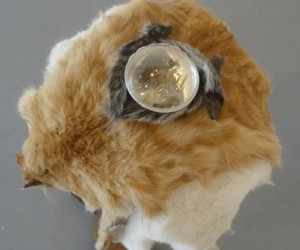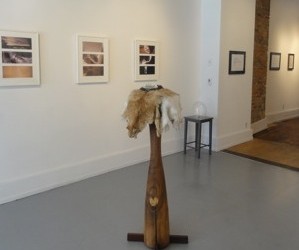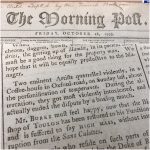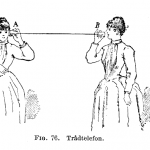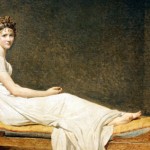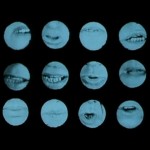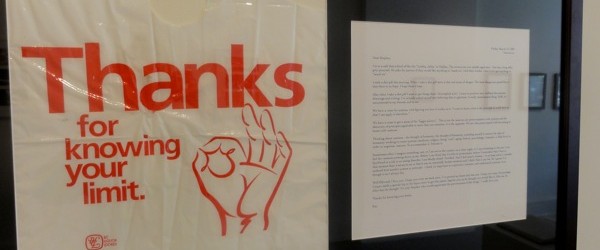
Duke & Battersby, multi-faceted artists
Artists, InterviewsThe east-to-west pairing of Canadian artists Emily Vey Duke and Cooper Battersby (Duke&Battersby) in the early nineties has made for nearly two decades of creative work. Installation, printed matter, curation and sound are their desired mediums with focus on single-channel video works. At gallerywest in Toronto, their exhibition Pain Shall be No More was on view during the month of July 2012, including new works and quite the centerpiece – a skinned cat and bones.
“First we want to make sure that people understand this: We love cats. We love cats with the crazed intensity that so many animal lovers exhibit. We can watch them for hours at a time. We call one another from another room to see them kicking their legs when they dream; or when they leap to catch flies; or when they purr especially loud; or when they look like miniature panthers.”
The mix between illustrations, photographs and installations – video too – with mild intricacies and meticulous insertions makes for a real eye stretcher, one that fashions a sort of cat expose.
The skinned cats (Turbine and Ellio) are two of the beloved cats Duke & Battersby shared together. The short domestic (white) Turbine was their worldly travel companion, having lived with the pair in eight difference cities and over twenty houses before dying in 2009. Ellio, the orange cat was a very outgoing cat who had an ongoing friendship with a skunk. With the instruction and help of friend and fellow artist, Dani Levanthal, Duke and Battersby skinned each cat. Both cats now rest as exhibited mementos.
“We did this because we couldn’t bear to lose the cats entirely, and we knew that in our world, according to the terms laid out in our secret manifesto, using them in our work was the best way to honour them.”
The two artists, who also teach at Syracuse University, took the time to give Zouch some background into their collaborative efforts, the focal points of the show and what it takes to make the relationship work.
How did you two start working together and what has the years upon years of working together taught you?
We started working together from the very beginning. For a lot of couples the fear of working together seems to be that if they work together they will lose some of the credit and recognition for the work they create. We always saw it as a way to gain. It doesn’t actually cost us anything to give some of the credit to someone else.
Working together is extremely rewarding and satisfying, we feel genuinely sorry for artists who are single or worse in a relationship with someone that they don’t get to share their careers with. Art is like going to the Grand Canyon. It is better if you have someone to make fun of it with.
What makes for a strong partnership in the art world?
At first it’s competition. When we met we were intimidated by each other, and always tried to take each other down. Seeing someone as more powerful but potentially conquerable is the ideal.
Later, whether you’re working independently or collaboratively, the key is to let go of any tendency toward competition—and especially it’s dark sister, professional jealousy. The thing is, there’s enough room for all of us, enough ears to hear all our voices.. Enough curiosity to go around.
After seeing everything put together (video, centerpiece, illustrations etc.)- Do you feel happy with the end result? Do you feel relieved?
Love it that you asked if we feel relieved. That is precisely it—relieved that we still have something to say, and relieved that it was fun and exciting to figure out how to say it.
What are some of the key points/pieces you hope viewers will take in when looking at the work?
We hope that people will spend some time looking at the tiny bones we’ve included in the show. There are maybe a hundred tiny bones, some of them as small as a human hair; some vertebrae thinner than a piece of paper. For some people they are overlook able. They are only what they are: tiny bones. But for us they are endlessly fascinating.
Right now we have a baby field mouse lying on a heating pad recovering (hopefully) from being attacked by one of our cats. Perhaps the bones are a way of asking the viewer to think about the way we relate to death. The mouse on the heating pad is almost unbearably cute. Are the bones cute? Why or why not.
How does your life as a professor differ from your life as an artist? What type of subject matter do you teach and why?
The classroom is a great place to field ideas, especially ideas related to critical theory. But it’s always a challenge for us to switch from practicing artist mode into teacher mode. The former is a pretty freewheeling course. It’s about exploring ideas that might have dark elements, about allowing ourselves to think and talk and draw and write in a way that is limitless.
Teaching is very much about boundaries. it’s about providing students with a safe place to experiment, to be wild with a safety net. Essentially, during the school year, it’s our job to create a container in which students can be limitless themselves.
But that shift is always hard.
What are some of your most proud accomplishments to date?
Maybe this sounds corny, but the best thing is knowing that we’ve moved someone with our work. It’s really that simple, that basic. Our aim with the work is to generate empathy—with our characters, with our sculptural objects even. And, of course, sometimes with us, or more precisely, with whomever the viewer imagines us to be.
How can people get more involved, learn more about each of your works and your collaborative work?
We are always excited to communicate by email with anyone who has questions or ideas that want to talk about. Our email addresses are emilyveyduke[at]gmail[dot]com and cooperbattersby[at]gmail[dot]com There’s also a lot of stuff on the website—writing and songs and all the videos. It’s dukeandbattersby.com.
In addition a new book, The Beauty Is Relentless is also available. Edited by Mike Hoolboom, the book is about the short movies of Emily Vey Duke and Cooper Bradley and features essays from well-known artists.
Emily Vey Duke and Cooper Battersby’s work has won the top prize at festivals in Ann Arbor and Chicago, and awards in, Zurich, and Hamburg.






